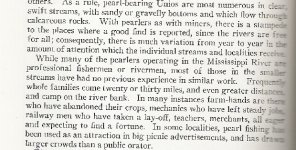Caitlin
Well-known member
Unios in Massachusetts LINK
FRESHWATER MUSSEL
For inquiries contact Doug Smith, Lecturer, Biology Department, University of Massachusetts Amherst
A conspicuous organism in the benthos of the Connecticut River is the freshwater mussel.

All freshwater mussels belong to the mollusk order Unionoida, a solely freshwater group. These animals are large (up to 150 mm or 6 inches in length) bivalved creatures possessing a hinge which is most developed posterior of the beaks or umbos. The shells are typically covered by a thick skin or periostracum that is variously colored and sometimes rayed on the disk depending upon the species. Internally, the shell has a "pearly" appearance due to the nacreous lining of the inner shell surfaces. These features have made freshwater mussels popular among collectors since the early 19th century.
In the region of the shell hinge, articulating "teeth" are variously developed or absent. When present, these teeth radiate from the beaks. The anterior teeth, when present, are called pseudocardinals and are thick, short, and, when well developed, grooved, and serrated. The posterior teeth, when present, are called laterals and are always elongate and lamellate.

The gross anatomy of North American freshwater mussels is characterized by the presence of an anterior adductor muscle (AA), a posterior adductor muscle (PA), a labial palp (P) for transporting food to the mouth, and a large muscular foot (F) which is used for digging and anchorage. The gills (a and b) are composed of a series of folded plates; two plates (demibranchs) occur on either side of the foot. Surrounding the animal and lining the inner surfaces of the shell is a mantle which is open along the margins of the shell. Posteriorly, the mantle margins, in conjunction with the demibranchs, form the inhalent (IN) and exhalent (EX) openings through which water circulates in the animal.

Species of freshwater mussels, exclusively among bivalve mollusks, produce a larva called a glochidium that is parasitic on fish or amphibians. The larvae, prior to release, are brooded in the parent's demibranchs (inner and/or outer gills) for a varying period of time depending upon the species. Metamorphosis to the adult morphology occurs while attached to the host. The vast majority of freshwater mussels, including all Massachusetts species, are dioecious. Adult freshwater mussels are infaunal filter feeders. Typically, the only movements undertaken are vertical adjustments of the animal's position in the substrate in response to changing environmental conditions. Migrations occur, but are usually of short duration and distance and, for the most part, are undertaken to withdraw from unsuitable habitats. Dispersal is principally accomplished during the parasitic larval stage. See reproduction for more information.
Two families of unionoid mussels are present in Massachusetts. The Margaritiferidae is represented by a single species, Margaritifera margaritifera, which is widespread in New England and northwestern Europe and Scandinavia. In North America, scattered populations occur in New York and Pennsylvania as well. Margaritiferids are chiefly distinguished from other unionoid mussels by a unique non-septate gill structure and a simple diaphragm, which separates incoming water in the branchial chamber from outgoing water in the suprabranchial chamber.
The other family occurring in Massachusetts is the Unionidae. This is the largest family of unionoid mussels and contains species living in North and Central America, and throughout the Palearctic region. Eleven species live in Massachusetts. All belong to a zoogeographical assemblage called the Atlantic Slope fauna. The Unionidae are characterized by the possession of gill septa in the demibranchs and a complex diaphragm.
The freshwater mussels are among the most endangered organisms in North America. About 3% of the North American fauna is extinct and nearly 50% of the species are considered endangered. In Massachusetts, seven of the eleven known species are protected by law. In the Connecticut River, only one species remain common, Elliptio complanata.
REFERENCES: Pennak, R.W. 1978. Fresh-water invertebrates of the United States, 2nd edition. John Wiley and Sons, New York.
Smith, Douglas G. 1995. Keys to the Freshwater Macroinvertebrates of Massachusetts. Published by D. G. Smith, Amherst, MA. Note: this book can be ordered for the very reasonable price of $22.50, shipping included (Mass. residents should also add 5% sales tax). If interested contact Doug Smith at (413)-545-1956 for more information.

